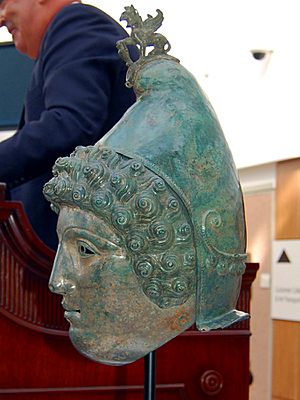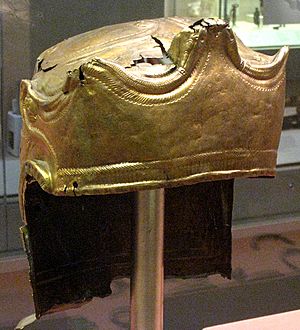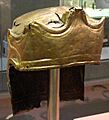Crosby Garrett Helmet facts for kids
Quick facts for kids Crosby Garrett Helmet |
|
|---|---|
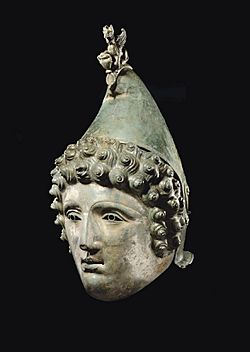 |
|
| Material | Copper alloy |
| Size | 407 millimetres (16.0 in) high |
| Created | Roman, 2nd–3rd century AD |
| Discovered | By a metal detectorist in May 2010 |
| Place | Crosby Garrett, Cumbria |
| Present location | Private possession |
The Crosby Garrett Helmet is a special Roman helmet made from a mix of metals, like bronze. It was created around 1,800 years ago, between the late 100s and early 200s AD. This amazing helmet was found by someone using a metal detector near Crosby Garrett in Cumbria, England, in May 2010.
Later on, experts found that the place where the helmet was discovered used to be a Roman-British farm settlement. This settlement was close to a Roman road and a Roman army fort. It's possible that the helmet belonged to a local person who had served in the Roman cavalry, which were soldiers who rode horses.
The helmet seems to have been carefully folded up and buried in a special stone structure. It was likely used for fancy ceremonies or parades, not for fighting in battles. It might even have been an old item when it was buried. This helmet is similar to others found in Britain, like the Newstead Helmet and the Ribchester Helmet.
Ralph Jackson, a senior expert from the British Museum, called the helmet "an immensely interesting and outstandingly important find." He said its face mask was "extremely finely wrought and chillingly striking." He believes it's a very important discovery for Britain and the world.
In October 2010, the helmet was sold at an auction for a lot of money, about £2.3 million (or US$3.6 million). It was bought by someone who wanted to keep their name private. The Tullie House Museum and Art Gallery in Carlisle tried to buy it with help from the British Museum, but they couldn't afford it. The helmet has been shown to the public four times since then, including at the Royal Academy of Arts and the British Museum. It also returned to Tullie House for an exhibition in 2017.
Contents
What Does the Crosby Garrett Helmet Look Like?
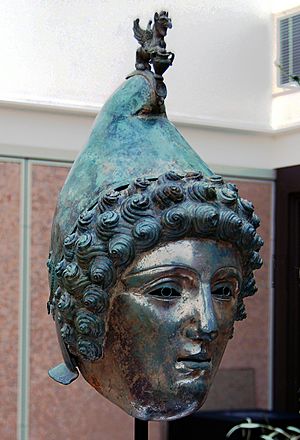
The Crosby Garrett Helmet is almost a complete Roman cavalry helmet, made of two main parts. The front part, called the visor, shows the face of a young man with curly hair and no beard. The top part of the helmet looks like a Phrygian cap, which is a soft cap with a point that bends forward.
On top of the cap, there's a winged griffin statue. A griffin is a mythical creature with the body of a lion and the head and wings of an eagle. This griffin stands with one foot on a pot, called an amphora. The visor was once connected to the top part with a hinge, allowing it to open and close.
The helmet was held on the wearer's head with a leather strap under the chin. You can still see marks on the helmet from where the visor was opened and closed. At some point, the helmet was even repaired with a bronze sheet. Only two other Roman helmets with visors have been found in Britain: the Newstead Helmet and the Ribchester Helmet.
What Is the Helmet Made Of?
The helmet and visor were made from a metal mix that was mostly copper (about 82%), with some zinc (10%) and tin (8%). This mix was probably made from melted-down old brass. Some parts of the helmet still show traces of a white metal coating. This means the visor was originally covered in tin to make it look like silver.
The griffin was made separately from a different metal mix, which had more tin and some lead. So, the visor would have looked silver, and the helmet would have looked like coppery yellow. Experts believe the helmet was made in the late 100s or early 200s AD. They can tell this from the type of decorated rivets used and other design details, like the pierced eyes.
What Does the Helmet's Design Mean?
People have thought a lot about what the helmet's design might mean. The griffin was often seen with Nemesis, the goddess of revenge and fate. Both were sometimes linked to death and gladiator fights.
The meaning of the face and the cap is less clear. Some ideas include the Greek god Attis, the hero Perseus, or Roman gods like Mithras and Jupiter Dolichenus. Others think it might represent someone from the Eastern Mediterranean, possibly a Trojan. The Phrygian cap was often used by Romans to show Trojans. Another idea is that it could represent an Amazon warrior.
How Was the Helmet Found?
The helmet and visor were found in May 2010 on a farm in Crosby Garrett, Cumbria. The person who found it was a metal detectorist in his 20s. He had been searching in those fields for years with his father, but had only found small items like Roman coins before.
The spot where it was found is near an old Roman road. There are also signs of an ancient settlement nearby that no one knew about before. This area was important because it was on the way to the northern border of Roman Britain. The Roman army would have been in this area and used the nearby road. A Roman fort was only about 9 kilometers (5.6 miles) away.
After the helmet was found, experts from the Tullie House Museum and the Portable Antiquities Scheme studied the area. They found that the ancient settlement was a large area surrounded by ditches, with buildings inside. This settlement combined both native British and Roman ways of building defenses. There might have been a paddock for horses, and signs of buildings were mostly in the northern part.
Old Roman-British farm fields in the area show that people grew crops and raised animals like sheep, goats, and pigs. Finding Roman pottery suggests that the people living there had started to use some Roman customs. However, the community might have been there long before the Romans arrived. Evidence suggests the site was first settled as far back as the Bronze Age, over 1,000 years before the helmet was buried.
The finder discovered the helmet and visor buried about 25 centimeters (10 inches) deep. It was placed on two stone slabs at the bottom of a hole, which was then filled with soil and covered with a stone cap. The helmet was found in 33 large pieces and 34 small pieces, and it looked like it had been folded before burial. The visor was mostly whole and placed face down. The griffin had come off but was found with the helmet.
No other old items were found right away. But later digs by the Tullie House/PAS team found other copper and iron objects, a bead, and two Roman coins from 330–337 AD. These coins were found inside the stone structure where the helmet was buried, so they might have been buried at the same time.
How Was the Helmet Restored?
The person who found the helmet didn't realize it was Roman at first. He thought it was a Victorian ornament. He figured out it was Roman by looking at auction catalogs, searching online, and asking experts.
Experts from the Portable Antiquities Scheme were told about the discovery and visited the site. Christie's, the auction house, hired Darren Bradbury, an expert restorer, to fix the helmet for sale. Even though some asked for the restoration to wait so more scientific tests could be done, this didn't happen. This might mean some information about how the helmet was buried was lost.
However, the British Museum was able to check the helmet during its restoration. They used a special test called X-ray fluorescence to find out what metals the helmet, visor, and griffin were made of. Mr. Bradbury's restoration work took about 240 hours. He fixed cracks and holes using resin and "Super Glue," making them blend in with the rest of the helmet.
How Was the Helmet Used?
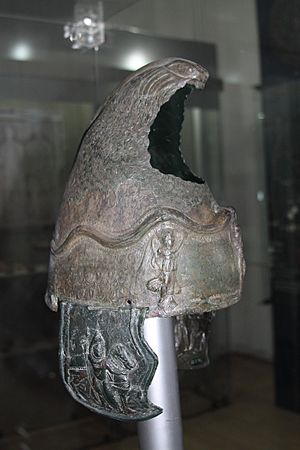
The Crosby Garrett Helmet is very similar to other Roman cavalry helmets. The visor is a special type used for cavalry sports. Similar helmets have been found all over the Roman Empire, from Britain to Syria. Its face looks most like a helmet found in Nola, Italy, which is now in the British Museum. The way the hair is done is like a helmet found in Belgrade, Serbia.
The griffin decoration is unique. The helmet's top part, shaped like a Phrygian cap, is also very rare. Only one other similar piece has been found, in Ostrov, Romania. Rings on the back of the helmet and on the griffin might have been used to attach colorful ribbons or streamers.
These types of helmets were used for hippika gymnasia, which were special cavalry tournaments. These shows were performed for emperors and important commanders. Horses and riders wore fancy clothes, armor, and feathers. They would act out famous historical and legendary battles, like the wars between the Greeks and Trojans.
A Roman writer named Arrian described these events:
Those of high rank or superior in horsemanship wear gilded helmets of iron or bronze to draw the attention of the spectators. Unlike the helmets made for active service, these do not cover the head and cheeks only but are made to fit all round the faces of the riders with apertures for the eyes... From the helmets hang yellow plumes, a matter of décor as much as utility. As the horses move forward, the slightest breeze adds to the beauty of these plumes.— Arrian, Ars Tactica 34
Regular combat gear was given out by the Roman army and had to be returned. But cavalry sports equipment seems to have been different. Soldiers often bought these items themselves. They could keep them after they finished their service. Helmets and visors like this have been found in graves and other places away from army sites. Sometimes they were carefully folded up and buried, like the Guisborough Helmet.
A historian named Johan Nicolay believes that ex-soldiers took some items home as a reminder of their time in the army. Sometimes they would bury them as gifts to the gods or as part of a burial.
The exact reasons why the Crosby Garrett helmet was buried are still a mystery. But the discoveries from the digs have given us more clues. It was clearly placed in a special structure that was built just for it. It was not buried in a lonely spot, but within a Roman-British farming settlement that had been lived in for a long time. This community had clearly adopted some Roman customs.
Since the settlement was close to Roman military places, it's very likely that some of its people served in the Roman army. The helmet might have been a valuable antique when it was buried. If the coins found nearby show when it was buried, the helmet could have been over 100 years old at that time. It was purposely broken before being buried, possibly as a special ritual. We will never know who owned it, but it could have been a local person who had served in the Roman cavalry.
Where Has the Helmet Been Displayed?
Since it was sold in 2010, the helmet has been shown to the public four times.
- It was lent by its owner to the Royal Academy of Arts in London. It was on display from September 15 to December 9, 2012, as part of an exhibition about bronze items.
- From November 1, 2013, to January 26, 2014, the helmet was shown at the Tullie House Museum and Art Gallery in Carlisle. A special guide was made for this display.
- It was then displayed at the British Museum from January 28 to April 27, 2014.
- The helmet returned to Tullie House to be part of their "Hadrian's Cavalry" exhibition. This exhibition was held at ten different sites along Hadrian's Wall from April to September 2017.
Images for kids


